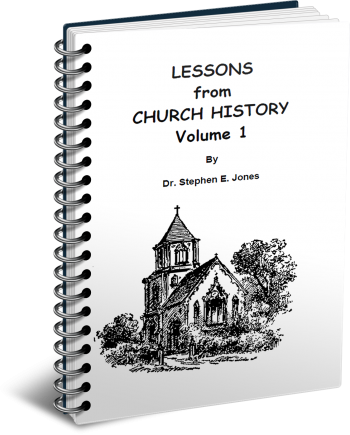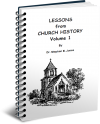Latest Posts
View the latest posts in an easy-to-read list format, with filtering options.

Volume 1. This gives a short history of the Church from the apostles to the Roman War, including Luke’s account of Paul’s journeys in the book of Acts. It includes Paul’s fourth missionary journey to Spain and Britain.
Category - History and Prophecy

The so-called “inner circle” of disciples consisted of Peter, James, and John--the disciples that Jesus took with him to the Mount of Transfiguration (Mount Hermon), as we see in Matt. 17:1. They are listed in that order, because they form a unique prophecy that is applicable to Church history.
Peter's Hebrew name was Simon, which means “hearing.” Jesus renamed him Peter, “stone,” after his great foundational confession and revelation that He was the Messiah (Matt. 16:13-19). As Simon Peter, he was the “hearing stone” (or hearing rock), and this was a reference to the time when Moses was supposed to speak to the rock in order to bring forth water (Num. 20:8).
Moses struck the rock on two occasions. The first time, he was supposed to do so, because it prophesied that Jesus, the Shepherd, was to be smitten (Zech. 13:7), that the world might receive the water of life. The second occasion, however, which prophesies of the second work of Christ, Moses was to speak to the rock, and the rock would hear and bring forth water for the world.
Pentecost marked the earliest beginning of the second work of Christ—His post-cross work—and Peter was the primary vehicle through which this work was to be established. Thus, we see Peter in the first part of the book of Acts as receiving a primary revelation once again, particularly in the manner of his calling to the house of Cornelius, the Roman Centurion.
This revelation revolutionized Peter's thinking, for he had been brought up to think that the non-Judean people were “unclean,” even if they were believers. Peter had a separatist mentality, and many years later, he nearly reverted to that way of thinking under pressure from his peers. He was stopped and corrected by the Apostle Paul himself (Gal.2:11-13).
Peter's incredible vision of the unclean animals being lowered down in a sheet for him to “eat” was not a revelation of food, but of non-Judean people that God said were “clean.” Peter later reported in Acts 10,
{Acts 10:28} 28 God has shown me that I should not call any man unholy or unclean . . . {Acts 10:34} 34 I most certainly understand now that God is not one to show partiality, {Acts 10:35} 35 but in every nation the man who fears Him and does what is right, is welcome to Him.
This was the foundational revelation necessary to begin the second work of Christ. Without it, Christianity would have remained a sect of Judaism and would soon have been persecuted out of existence. Even as Moses was to SPEAK the word to the hearing rock to bring forth water, so also this Gospel was to be preached in all the world.
Moses, of course, disobeyed in this instance, for he struck the rock again, as if to crucify Christ afresh (Heb. 6:6), and this single act disqualified him from entering the Promised Land (Deut. 32:50, 51).
Peter laid the foundational revelation when he returned to the Church in Jerusalem and reported to them that the Roman Centurion and his non-Judean friends had received the baptism of the Holy Spirit, even as they themselves had on the day of Pentecost (Acts 10:44). In other words, God did not reserve His Pentecostal blessings for a chosen few. The chosen few were privileged to receive it FIRST, but not exclusively.
In fact, Philip had already gone to Samaria with the Gospel, and Peter and John had already laid hands on the Samaritans, who received the Holy Spirit (Acts 8:17). So this revelation to Peter in regard to Cornelius should not have come as a great surprise. The Samaritans were despised, and the Romans were feared, but both were hated and considered by the “traditions of men” to be “unclean.”
The point of this, however, is to show that the impartial character of God was the foundational revelation of the early Church, and Peter's change of heart was one of the real “keys of the kingdom.” Even so, this very issue became the most divisive issue in the first decades of the Church. Philip Schaff's History of the Christian Church, Vol. 1, p. 256, (1858) speaks of this division, and how it was resolved in Acts 15 at that first council:
“But he[Peter]stood mediating between James, who represented the right wing of conservatism, and Paul, who commanded the left wing of the apostolic army.”
Running directly parallel to this, of course, was the fact that women received the Holy Spirit at Pentecost alongside of the men. In traditional Jewish circles, the men and women would have been separated, and the dividing wall in the temple kept women as well as gentiles at an arm's distance from God. The unlawful nature of these traditional separations was corrected by Pentecostal revelation, so that Paul could write later in Gal. 3:28,
{Galatians 3:28} 28 There is neither Jew nor Greek, there is neither slave nor free man, there is neither male nor female; for you are all one in Christ Jesus.
In the first decade of the Church, from 33-44 A.D., there does not appear to be any single leader in Jerusalem, though Peter and John surely assumed leadership roles. During this time, James was sent as a missionary to Spain, and when he returned in 44 A.D., he was martyred under Herod Agrippa I (Acts 12:2). The angel of the Lord released Peter, of course, and we read in verse 17 that “he departed and went into another place.” It is likely, according to other Church historians, that he went to Antioch to begin the work there. It was needful that he leave Judea, for his life would be in constant danger from that point on.
It was at this time that Jesus' brother, James, became the head of the Jerusalem Church. He was finally martyred in 62 A.D. on the temple grounds, though he was held in high esteem by the traditional Judean worshippers there. In fact, Eusebius, bishop of Caesarea in the fourth century, mentions his martyrdom and lists it as a primary cause of God's judgment upon Jerusalem a few years later. That final war began in 66 A.D. Eusebius writes in Eccl. Hist., II, xxiii,
“This is the full account which, in agreement with Clement, is given by Hegesippus. So remarkable a person must James have been, so universally esteemed for righteousness, that even those more intelligent Jews felt that this was why his martyrdom was immediately followed by the siege of Jerusalem, which happened to them for no other reason than the wicked crime of which he had been the victim. And indeed Josephus did not hesitate to write this down in so many words: ‘These things happened to the Jews in requital for James the Righteous, who was a brother of Jesus known as Christ, for though he was the most righteous of men, the Jews put him to death’.”
The present version we have of Josephus does not word it quite this way, though it does refer to James as “the brother of Jesus who was called Christ.”
Notwithstanding Peter's great revelation and Philip's evangelization of Samaria, the problem with discrimination continued under James' leadership. James tried very hard to be a witness to those still adhering to Judaism and prayed for them continually. Because he was a Christian and the brother of Jesus, he had to be ultra-scrupulous in keeping the Jewish traditions in order to avoid criticism. He continued to observe the sacrificial laws, along with all the other temple practices. But in the end, none of that mattered, for the priests killed him anyway merely for testifying in public that Jesus was the Christ.
Incidentally, Albinus, the Procurator, and Herod Agrippa, deposed the high priest Ananus for this crime, for they disapproved of the murder.
Symeon then took James’ place. According to Hegesippus, he was a cousin of Jesus and of James. He was also the son of Clopas, or Cleopas (Luke 24:18), and he led the Church out of Jerusalem before its destruction. He continued to lead the Judean Church until his martyrdom under Trajan in 107 A.D., when he was 120 years old.
The destruction of Jerusalem resolved the issue of temple sacrifices, for they ceased by necessity. But the problem of discrimination in the early Church only reluctantly died out. Its appeal to the flesh has resurfaced in the past century with the rise of Dispensationalism and its illegitimate son, Christian Zionism.
Paul began his ministry in 47 A.D. during the ministry of James. In some ways James and Paul represent two sides that seem contradictory but in fact work together. Church history has continued the struggle to find that point of agreement. But even as John remained largely silent in the background until the others had died, so also do we find John's ministry most relevant at the end of the Pentecostal Age.